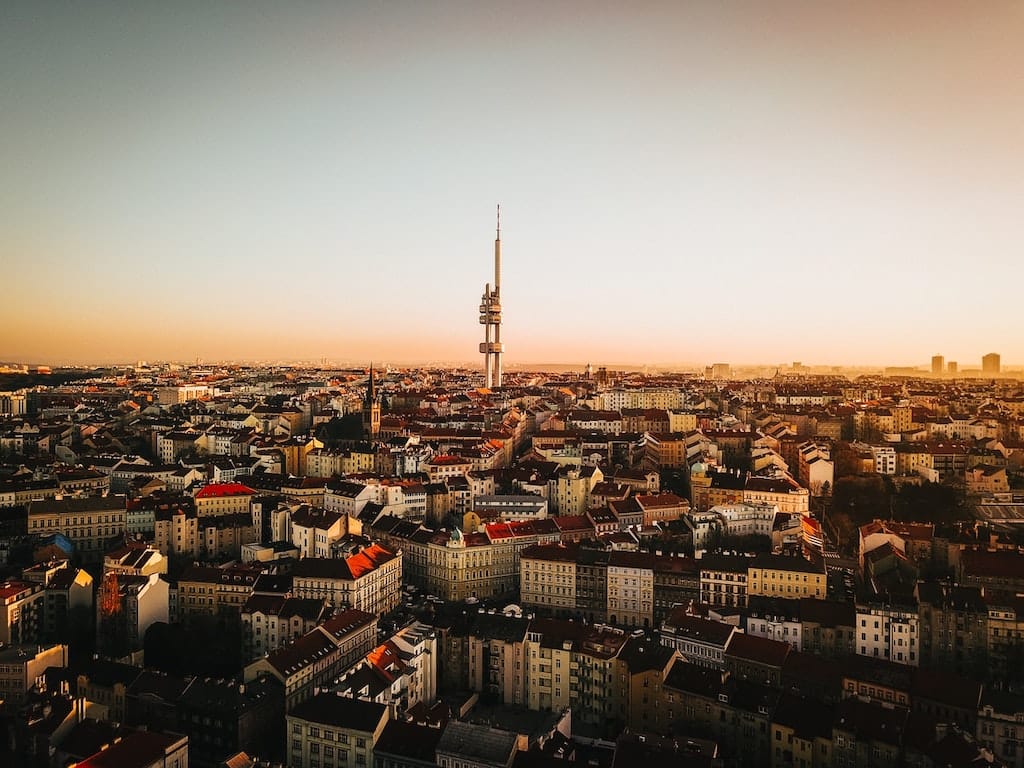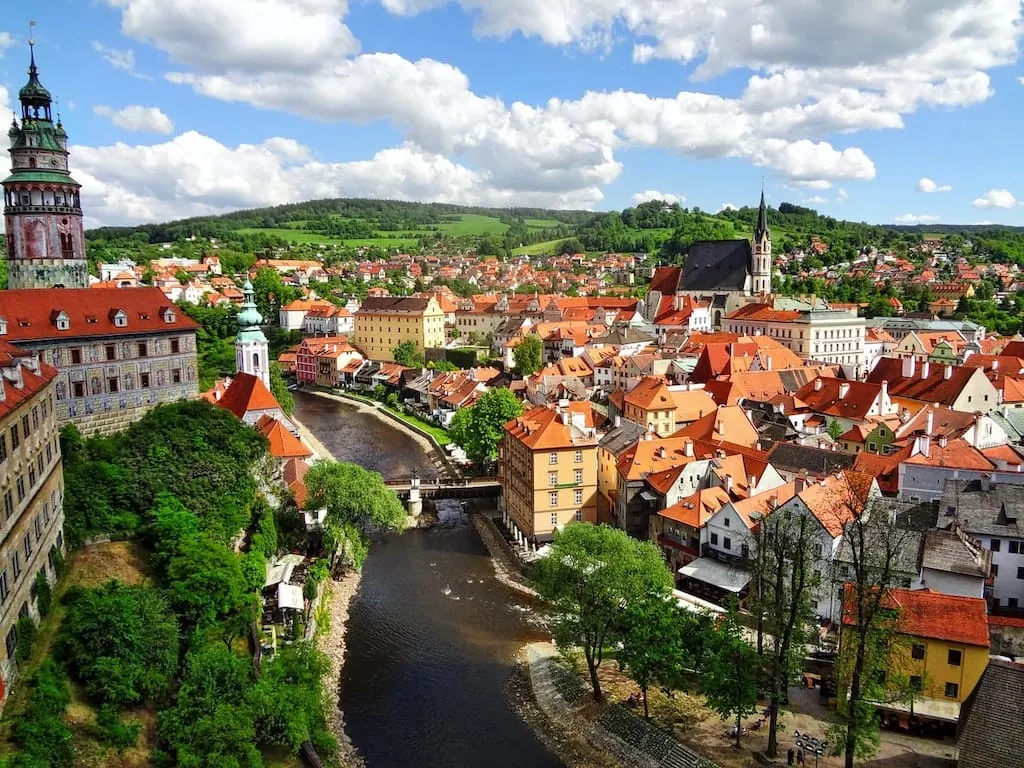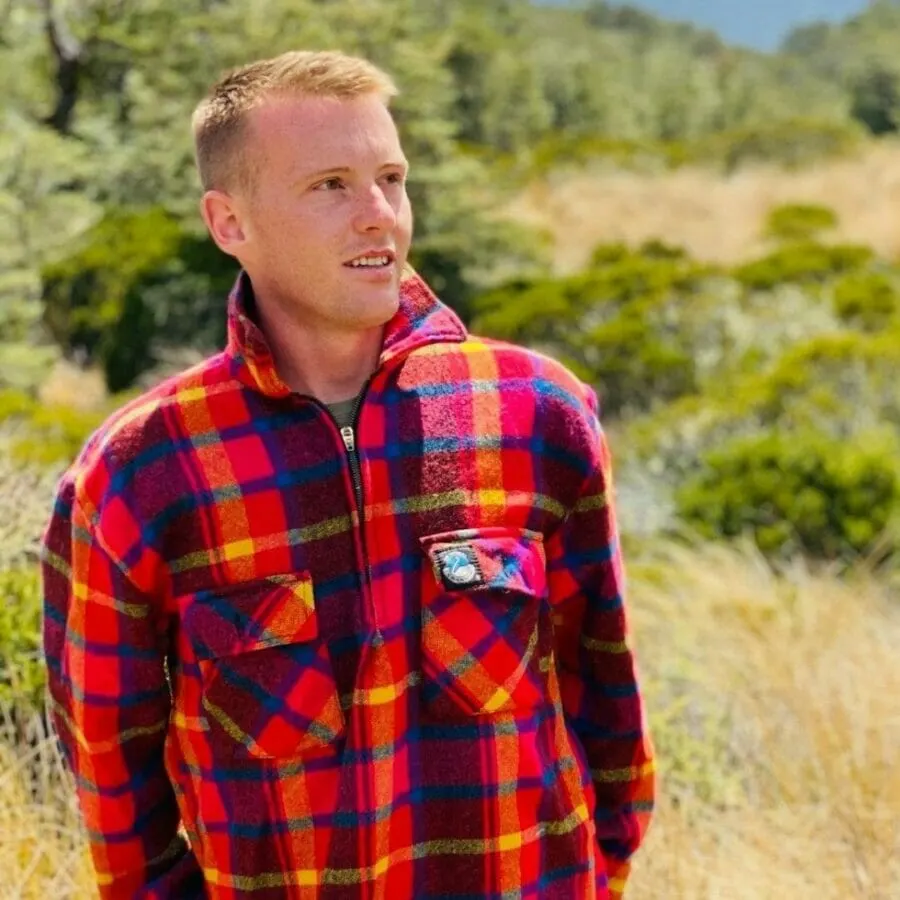Expert travel storyteller Jordan Adkins, founder of InspiredByMaps.com, brings a decade of adventures across 101 countries and 450+ UNESCO sites into rich, off-the-beaten-path narratives, melding ecological expertise with genuine, seasoned travel insights. His full bio can be found here.
The Czech Republic is one of the most engrossing travel destinations in the world, an intertwined mess of historical and contemporary excitement from the history-soaked streets of Prague to the charming gardens of Kroměříž’s and storybook-esque Český Krumlov.
There’s so much to see here but exploring the Czech Republic’s most iconic landmarks is a perfect place to start …
There are beautiful cities, architectural landmarks, touching tales, small towns, stately homes, parks, farms, art and design, exhibitions and lots of customs and rituals. As you would expect in a proud nation with a long and storied history.
It is possible to forget in the middle of all this, that this Central European country also has some beautiful scenery with rolling hills, low mountains, and more than a few national parks to explore.
In the Czech Republic there’s just so much to visit; you might spend a lifetime enjoying its wealth and only just begin to scratch the surface. That’s why we created this cheat sheet to support you on your journeys.
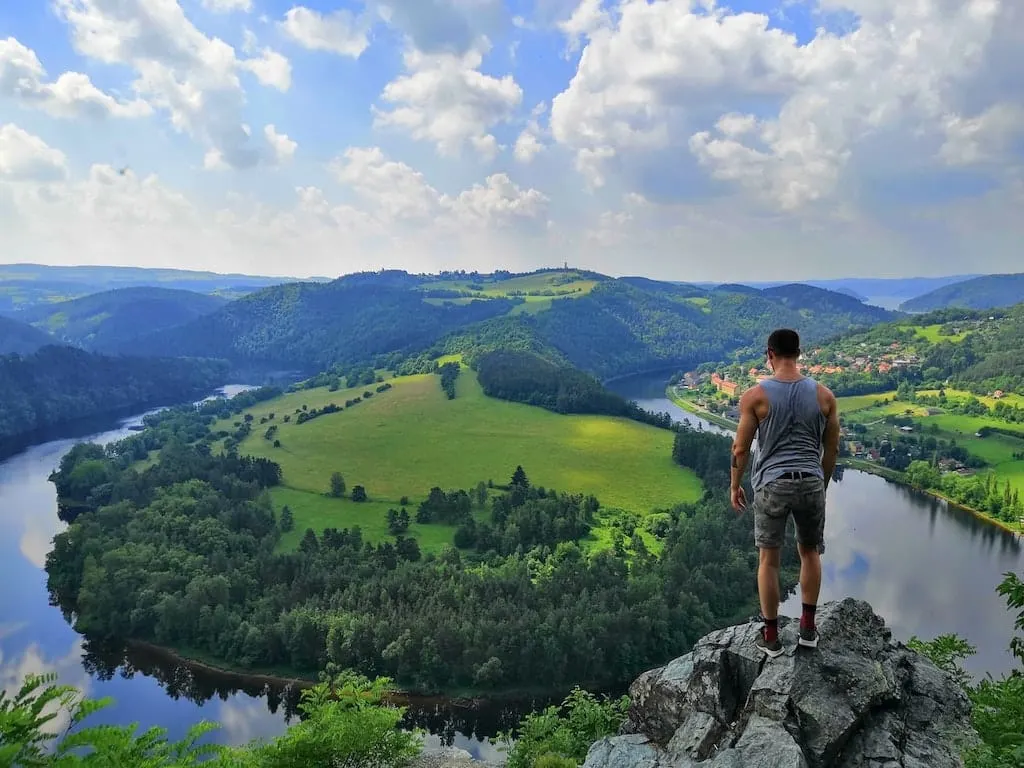
But first – what is a landmark?
A landmark is a distinctive natural or artificial attribute that usually stands out from its surroundings and has become an emblem of local or national character. A landmark is helpful for urban visitors, both in terms of being a tangible waypoint and in trying to assist you coordinate your itinerary.
Getting off the beaten track is all well and good, but at the end of the day, there are some places you just need to see when you visit a country. Immediately recognizable places that you couldn’t miss if you tried – like the Great Wall of China or Christ the Redeemer in Rio de Janeiro. And the Czech Republic has more than just its fair share …
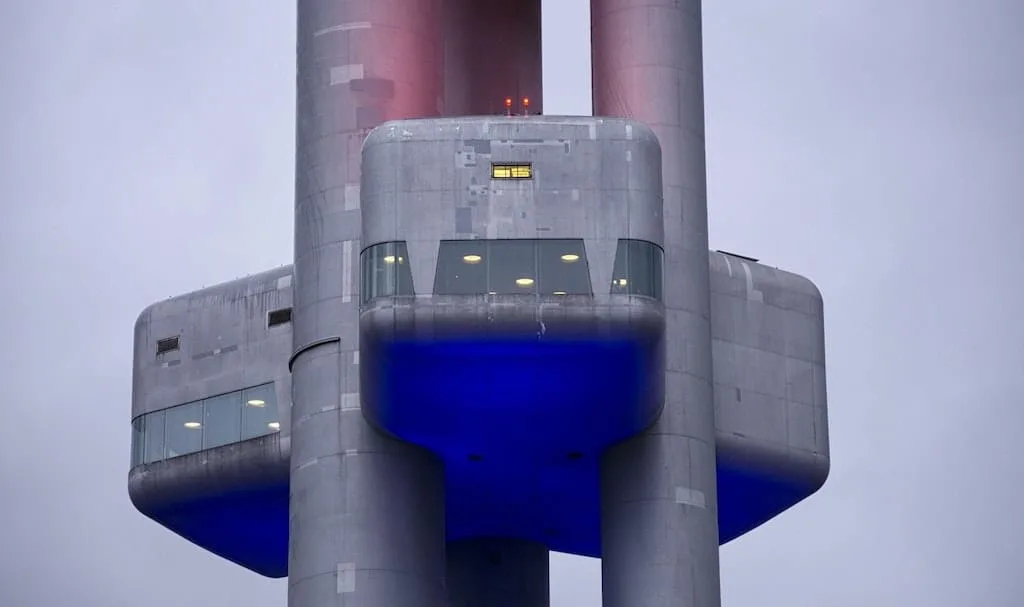
When approaching a trip to the land of Budweiser and castles, you will want to tick off as many famous Czech landmarks as you can – and the best way is to do that is often by renting a car, taking a tour, or using the Eurail Pass to get around.
There is a lot to explore in the Czech Republic — and no list of famous Czech landmarks can ever be exhaustive. But, we’ve tried to get the best bits by calling out to our favorite travel bloggers and asking them to give us tales and helpful tips about their best-loved ones.
This way, you have an appropriate frame of reference to motivate your journeys to the Czech Republic, from which you can select a few landmarks that you truly can not miss … Or shoehorn as many of them as feasible on a single trip.
If you plan your Czech trip right — and you’ve got enough time — you could just hit them all. Czechia is not a vast country after all. And discover a great deal more of your own highlights of the Czech Republic while you’re at it!
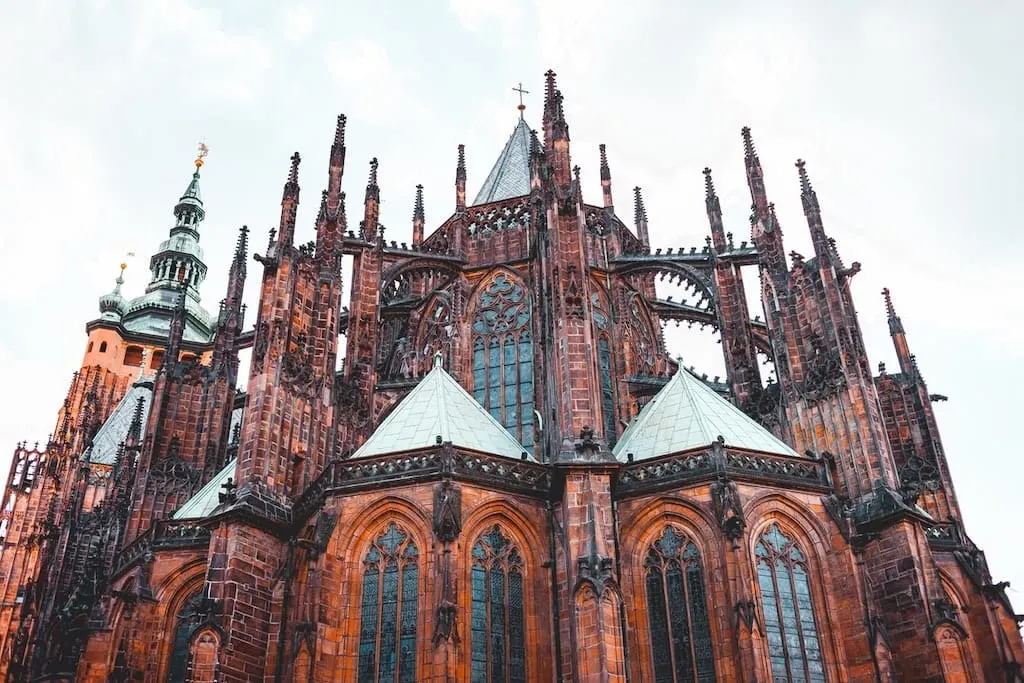
Page Contents
- Bohemian Switzerland
- Bouzov Castle
- Budweiser Budvar Brewery
- Cathedral Of St. Peter And Paul In Brno
- Cesky Krumlov Castle
- Charles Bridge
- Dancing House
- Harrachov Ski Jumping Stadium
- Head of Franz Kafka
- Historic Underground Of Plzen
- Holy Trinity Column
- Ještěd Tower
- Karlstejn Castle
- Konopiste Castle
- Kunětická Hora Castle
- Lennon Wall
- Lidice Memorial
- Mill Colonnade
- National Theatre Of Prague
- Old Jewish Cemetery In Prague
- Pilsner Urquell Brewery
- Prague Astronomical Clock
- Prague Castle
- Prague Christmas Markets
- The Historic City of Telč
- Villa Tugendhat
- Žižkov Television Tower
Bohemian Switzerland
Bohemian Switzerland is a mountain range in the northern Czech Republic, characterized by its picturesque sandstone mountains, several unique landmarks, and endless hiking trails. It’s a 1.5-hour drive from Prague and located along the Czech-German border southeast of Dresden.
What’s unique about Bohemian Switzerland is the huge amount of bizarre rock formations, which are part of the Elbe Sandstone Mountains. The most famous example of natures’ creativity is the Pravčická brána (Prebischtor), the largest natural sandstone arch in Europe with an impressive span of 26 meters, which can be reached hiking from Hřensko.
The combined Edmund’s Gorge and Wild Gorge is another attraction in Bohemian Switzerland: two rocky ravines which can be accessed partly by hiking, partly by boat. A third example of the unrivalled rock formations is the labyrinth of Tisá (Tiské stěny), where you can walk on the finest (sandstone) sand through a never-ending compilation of skyrocketing rock needles. Its picturesque scenery shines through at all times, no matter where you are in this region!
A part of Bohemian Switzerland is also declared as a national park (České Švýcarsko National Park), which continues on the German side as national park Saxon Switzerland. The highest mountain of Bohemian Switzerland (Děčínský Sněžník), with marvelous views of both countries, is located outside of the national park area and can be reached from Germany and the Czech Republic as well. In general, both countries are well-connected in this region and offer various cross border hiking trails.
When visiting Bohemian Switzerland, I recommend to stay 2-3 days and base yourself either in Hřensko, Děčín, or on the German side in Bad Schandau. A rental car makes the trip much easier, especially when accessing the trailheads for hiking, but you can also arrive by train through the intercity stations in Bad Schandau (30 minutes from Dresden) and Děčín (1.5 hours from Prague).
Explored by Chris from Punta Cana Travel Blog
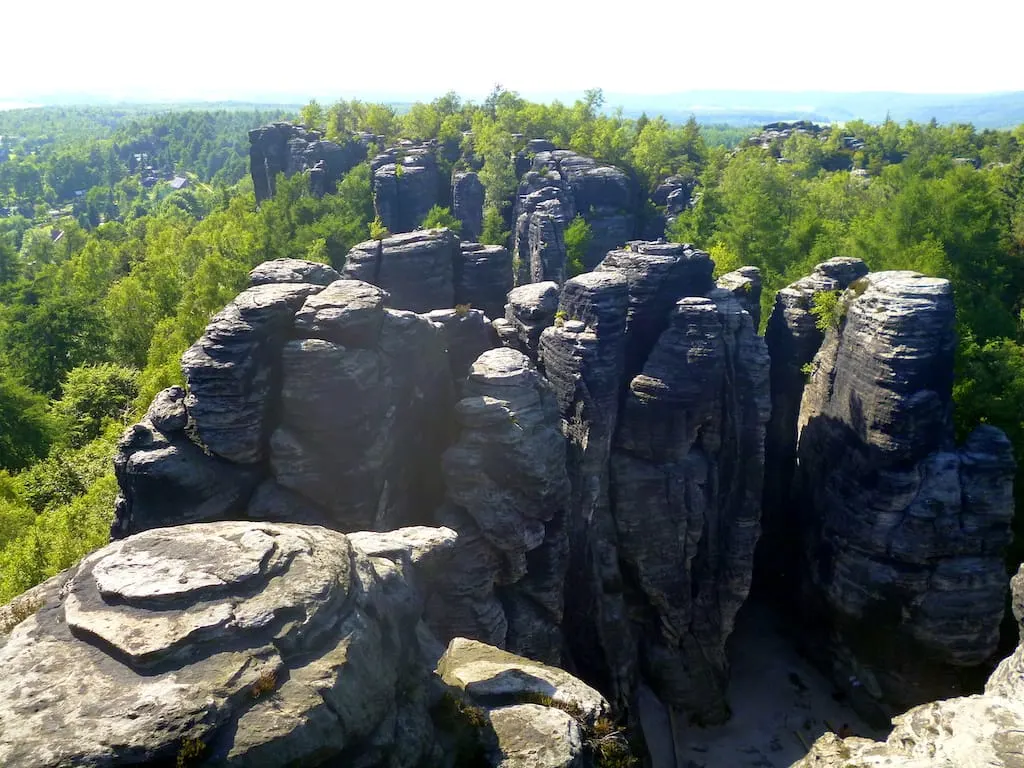
Bouzov Castle
Bouzov Castle is located in central Moravia, between the towns of Litovel and Svitavy. From Prague, it’s about 3 hours of driving along the roads E67 and E442. The iconic castle dominates the small village of Bouzov, where it was gradually built as a noble seat of local barons. Like all medieval castle, Bouzov was rebuilt and expanded several times to suit the reigning nobility.
During the course of time, the castle played an important role as a seat of the Teutonic Knights, then Hussites, and later the Nazis. Today, it is an important cultural heritage site that welcomes thousands of visitors every year. The fortress is richly furnished with luxury period furniture, intricately carved wooden paneling, historical artifacts, decorative objects, and artwork.
The castle is not a typical hilltop structure but has an impressive layout of an inner court inside of an outer court. It is equipped with watchtowers, drawing bridges, moats, and bastions. It serves as a popular location for filmmakers.
If you want to visit Bouzov, come between Early spring and late autumn because the castle is closed during the winter months. They offer several tours that take between 45 minutes to 2 hours. If you have time after the tour, go for a walk around the castle. The parkland offers nice trails with different angle views of the castle. Don’t forget to stop by in the castle restaurant for a refreshing glass of famous Czech beer and a dish of vepro, knedlo, zelo (pork, dumplings, and sauerkraut).
Explored by Slavka from On 2 Continents
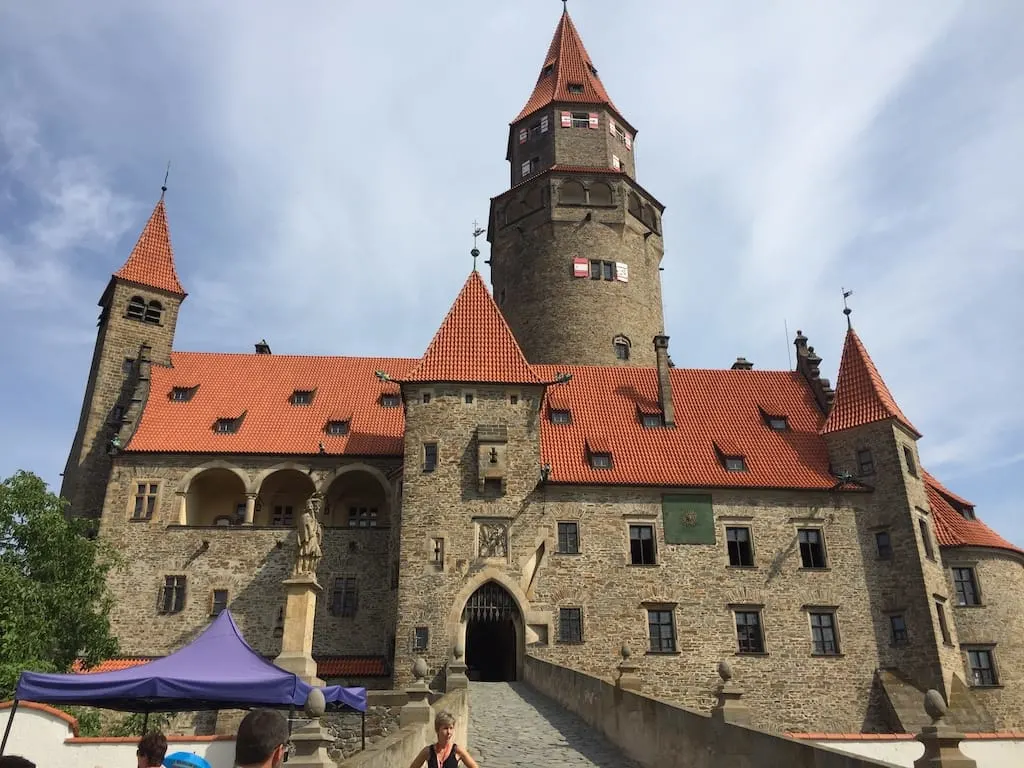
Budweiser Budvar Brewery
Whether you’re here for craft beer or castles, there’s no denying one of the most famous landmarks in the Czech Republic is the Budvar beer factory in Ceske Budejovice, home of the original Budweiser beer!
That fact is lost on many, including lovers of Budweiser beer. But not only is Budvar unique to the Czech Republic, the taste is also very different from the Budweiser sold in many parts of the world. And finding out more about the origins of this famous Czech beer is one of the most interesting things to do in Ceske Budejovice.
The history of brewing beer in the Czech Republic dates back to 1265, though the original Budweiser Bürgerbräu was founded in 1795. You may be wondering about the unique taste of Budvar and why it’s called the original Budweiser, and the first is easily answered. Budvar is brewed in the true Czech style using artesian water from Bohemia, and locally grown varietals of barley and hops. Budvar brewed anywhere else in the world just wouldn’t taste the same.
As for the original Budweiser brand — that comes down to trademarks, money, and centuries of litigation that still lingers to this day, after businessman and German immigrant to the US Adolphus Busch began brewing beer in the mid-1800s and borrowed the name from the Czechs.
Ceske Budejovice is located in south Bohemia, about an hour or two from Prague, and the factory is located just north of the historic town center. Tours are conducted daily at 2:00 pm, and the cost is nominal at around 100 Czech Korunas (not quite 4 Euros). The small onsite factory museum is interesting too, but the best part of the tour is, of course, the small tastings throughout — the ultimate appreciation of a true original.
Explored by Lori from Travlinmad.com
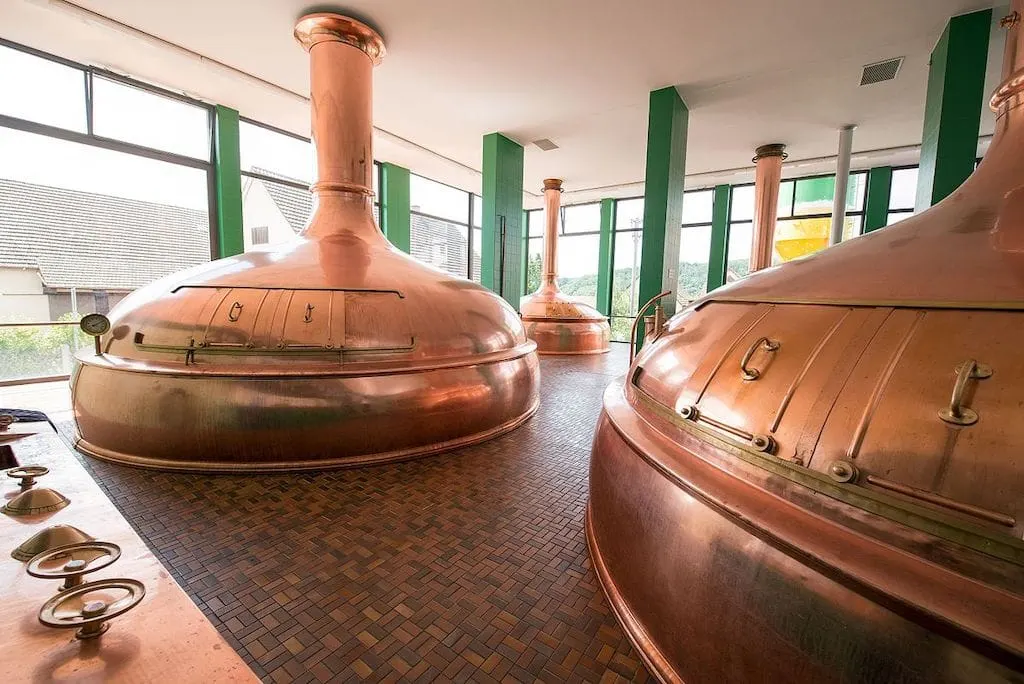
Cathedral Of St. Peter And Paul In Brno
The Cathedral of Saint Peter and Saint Paul is one of the main things to see in Brno and a landmark of the Czech Republic. The church, which is featured on the 10-crown coin of Czechia’s currency, sits perched atop Petrov Hill towering over Old Town Brno.
Dating back to the 11th century, the chapel on the hill is one of the most prominent features in the city. Although it has been entirely rebuilt and reconstructed several times, the original crypt beneath the church remains. The church is open to the public, although visitors must pay a small fee to climb the steeple or tour the crypt.
Unlike most churches, the bells at the Cathedral of Saint Peter and Saint Paul toll at 11 am rather than at noon. This tradition may confuse visitors initially, but the reason for the premature bell toll dates back to the 30 Years War in the 1600s. Legend has it, Brno was under siege by the Swedes, who pledged to abandon their attack if they did not conquer the city before the bells rang at noon. To trick their attackers, those defending the city rang the bell an hour early. The tradition has continued in remembrance for 400 years.
While visiting this national monument, be sure to walk around the cathedral and observe the numerous statues and sculptures that add to the church’s beauty and uniqueness.
Explored by Melissa from Parenthood And Passports
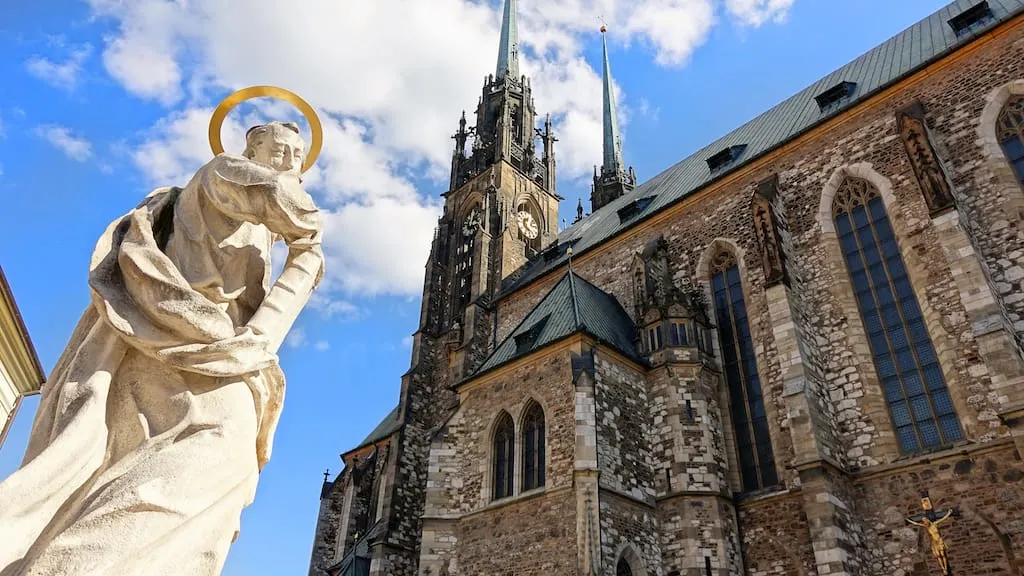
Cesky Krumlov Castle
If you enjoy visiting castles, you should put Cesky Krumlov Castle on your bucket list. Located on the southern bohemian part of the Czech Republic, in the fairytale town of Cesky Krumlov, the castle and chateau is part of the UNESCO Heritage Site. Perched on a hill overlooking the winding Vltava River, Cesky Krumlov Castle is the 2nd largest castle complex in the Czech Republic, next to Prague castle.
The history of the castle dates back to the 1240s when it was built by the Lord of Krumlov. With no succession, the castle was passed over to the Rosenberg family. For the next three centuries, the Rosenberg’s managed the castle. During this time, the castle underwent extensive work and reconstruction. The last member of the Rosenberg family sold the castle to the bohemian emperor, which was later inherited by the Eggenberg family, followed by the Schwarzenberg family. Finally, in the 1950s, the castle was transferred to Czechoslovak State.
The castle can be accessed from the Latran Street through the bright red colored gate that takes you directly into the courtyard.
The castle features different types of tour that focusses on various rooms and historic periods. Tour 1 focusses on the castle interiors during Renaissance and Baroque periods (16th – 18th centuries). This tour includes the Castle Chapel of St. George, Eggenberg Hall, with a magnificent “golden” carriage, and Masquerade Hall. Tour 2 focusses on the history and life of the Schwarzenberg family, taking through the portrait galleries and private rooms.
Other top attractions inside the castle include a well-preserved Baroque theatre, Wenceslas cellars, a castle museum, and the castle tower. The colorful facades of the castle, its paintings, and murals of Castle Tower are sure to capture your attention. Take the spiral staircase and enjoy the well-deserved stunning views of Cesky Krumlov. The tower is one of the iconic symbols of Cesky Krumlov town.
Walk up the hill to reach the Castle Gardens. The easiest way to get to Cesky Krumlov is by car. Take the route D1 to E55 towards Cesky Krumlov. Alternatively, there are buses and tours from Prague that takes approximately 3 hours.
Explored by Anuradha from Country Hopping Couple
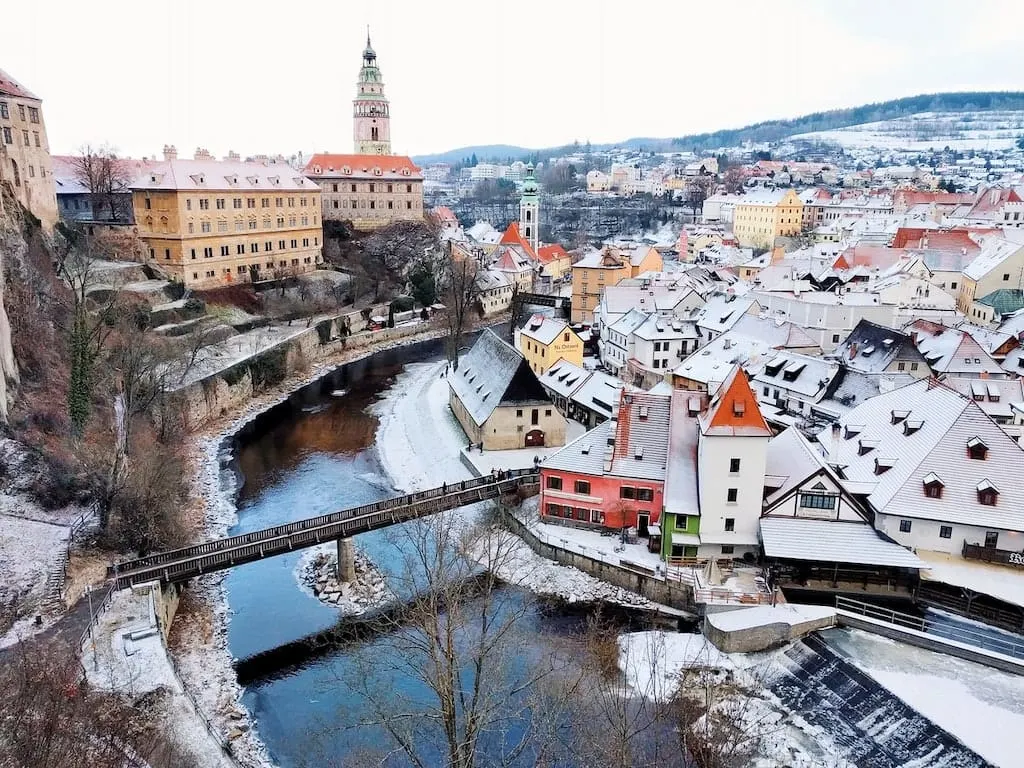
Charles Bridge
Charles Bridge is one of the most iconic landmarks in the whole of the Czech Republic, and it is a must-visit for your central European itinerary. Situated over the Vltava river in the capital city of Prague, Charles Bridge has been of historical significance since the 15th century. It is one of the most remarkable of the 17 bridges that exist over Prague today and one of the most beautiful bridges in the world – up there with Story Bridge in Brisbane and the 25 de Abril Bridge in Lisbon.
The bridge’s construction began in the 14th century; it was meant to connect Prague as a trade route between the eastern and western European states. Later on, by the 19th century, the Charles Bridge served as a connection point between Prague Castle and the Old Town.
Charles bridge shouldn’t be missed on your trip to Prague. It only takes 7 to 10 minutes to walk across the bridge, end to end. Take time to explore the intricate statues on the bridge, and soak in the views of the Vltava river.
There are about 30 statues in total. These statues are of prominent saints and priests, and they are made in Baroque style. All of the sculptures on the bridge are made of sandstone except for one. And this one is special. And that is the statue and plaque of John of Nepomuk. This statue is made of bronze and is considered to bring in good luck if one touches the surface of the statue and the plaque. The plaque looks sparklingly new due to the centuries of touching and polishing/praying by countless.
The bridge is filled with activities, from street artists, painters, and hawkers selling souvenirs. Note that this area is notorious for pickpocketing related issues, so stay safe and be careful when you explore the area of the old town and Charles Bridge.
It is very easy to locate Charles Bridge. Although there is no direct train or tram line from Prague airport to the bridge. You can, however, take a tram to the old town and then walk to the bridge area. If arriving from the side of the river, where the Prague Castle is, one can walk from the castle to Malostranské náměstí Square or take a tram. Either way, a short walk is a must to reach the bridge itself.
Explored by Mayuri from ToSomePlaceNew
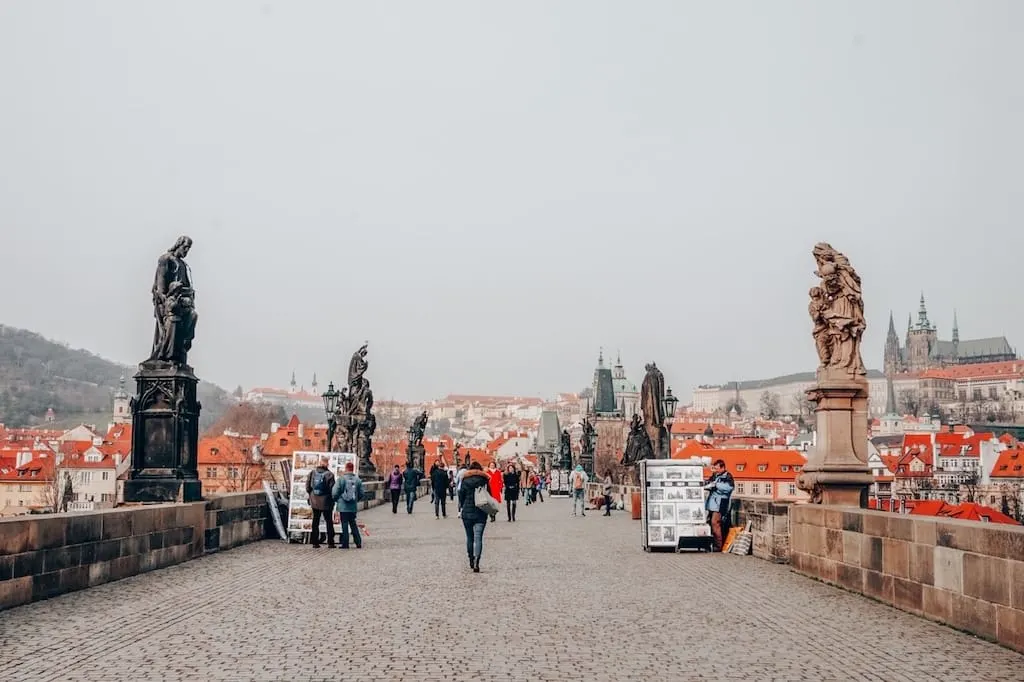
Dancing House
Prague has many contemporary points of interest. One of them is the Prague Dancing House, a very original structure that reflects and is indeed influenced by a famous of famous dancers – Fred Astaire and Ginger Rogers. The Nationale Nederlanden construct, also known as the “Dancing House” or often just “Fred and Ginger,” is one of Prague’s most famous landmarks, and probably the most globally renowned piece of Czech architecture post-1989.
It is home to approximately 3000 sqm of office space, an eatery, an art gallery, and a conference center. Most notably, on top of it is a viewing terrace from which you can glimpse Prague’s remarkable panorama. An illustration of deconstructivist architecture style, the oddly shaped structure is built on a reinforced concrete framework with 99 neighboring facade panels of various shapes. The principle face consists of two towers which represent the dancing duo. There is a dome above the Dancing House, called “Medusa” because of its shape. The tower has nine floors, and inside there are many asymmetrical spaces.
These days, the Dancing House building is one of Prague’s most prominent postmodern buildings and a critical component of the architecture of the Czech capital, but there have been occasions when it has caused considerable debate. The building’s critics were adamant that the Dancing House just wouldn’t blend with its surroundings, as most of its neighboring houses are in Art Nouveau style (Prague is an Art Nouveau hotspot – much like Vienna and Helsinki).
There was also a major debate over the building’s somewhat irregular design, with the towers leaning to the side. The Dancing House has proven to be a real architectural jewel of Prague, though, and nowadays, you will be unlikely to find someone who does not like it or at least support it.
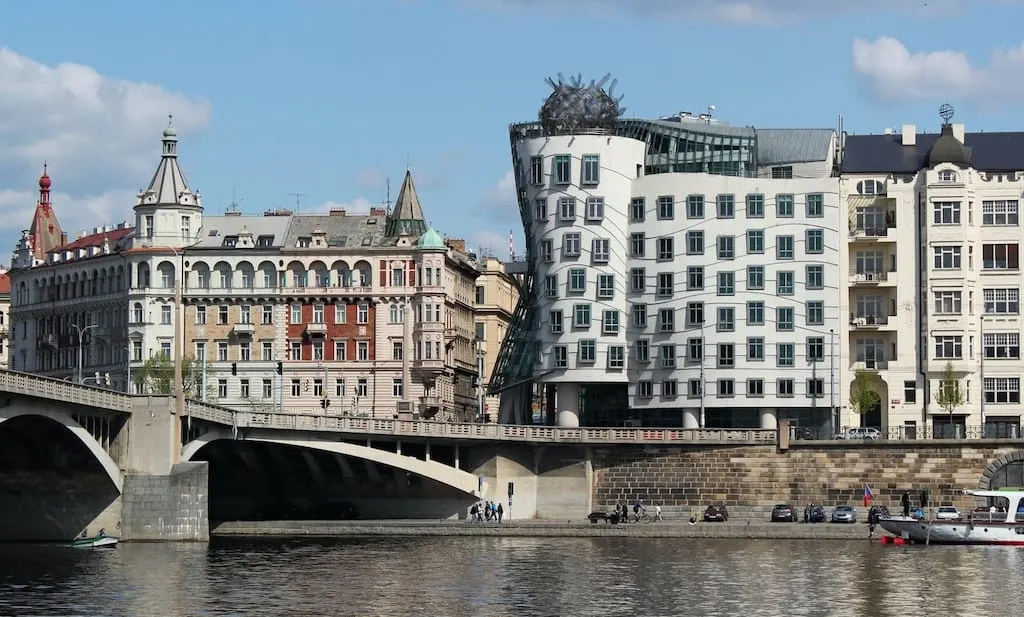
Harrachov Ski Jumping Stadium
Čerťák is a ski jumping hill complex consisting of 5 facilities, located in Harrachov on the slopes of Čertova mountain. The complex consists of: the mammoth hill with a construction point located at 185 meters, large (K125), normal (K90), and two medium ones (K70 and K40). It is divided into two parts: the two largest objects lie next to each other; the rest are on the other side of the hill.
The jump stands built-in 1980 can accommodate up to 50,000 spectators. The facility is equipped with artificial lighting, which was installed in 2009. The location of the complex is characteristic – it is located quite high, and the jumpers are exposed to strong side gusts of wind, and to minimize its impact, sheets of fabric have been hung along the run. World Cup competitions were held on the mammoth, and large ski jumps in 1985-2014. The longest jump on a mammoth hill was made in 2013 by a Slovenian jumper Jurij Tepeš, and it was as much as 220 m.
In 2014, the last jumps on the mammoth hill were made, and since then it has been closed. In 2017, Czech youth launched an initiative called “for the mammoth,” which was aimed at preventing the complete destruction of the facility and collecting funds for its reconstruction. They succeeded, and currently, the hill is being reconstructed.
Harrachov is located in the Northern Czech Republic in Karkonosze (Giant Mountains). The first ski jumping hill was built here already in 1920. Besides ski jumping, the town is famous for its glass factory with exquisite glass products and an in-house brewery (which means you can order a beer in a freshly made glass).
Explored by Anna from Liquid Traveling
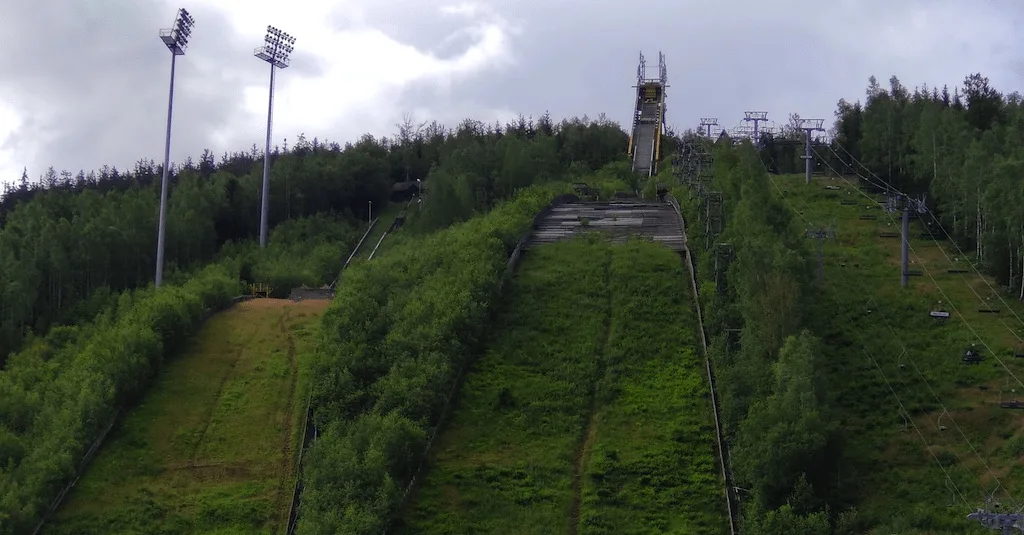
Head of Franz Kafka
Of all the most well-known artist/sculptor in Prague, one that you’ll probably see all around the city in many of the public squares may have the work of famous sculptor David Cerny.
An avant-garde artist on the cutting edge of public work that shows an irreverent side and pokes fun at politics and popular figures of his time frame, David Cerny has created a solid collection of large scale public sculptures. One of his fascinating pieces is a depiction of Frances Kafka, located at a new mall in the new part of the city — and a newly famous landmark of the Czech Republic.
The rotating head is dissected and moves in so many different patterns that create changing patterns and reflections along with different sounds that emanating from the rotating head. It’s fun to just sit in the square and observe the ever-changing head and also enjoy all the activity and people watching around the square. David’s work is located in many interesting squares, streets, and even hanging upside down as his famous work person depicting Sigmund Freud and hanging precariously from a pipe attached to a roof and overlooking the busy street below.
It’s fun to explore the streets of Prague and happen onto these amazing works from this prolific favored Prague artist for everyone to enjoy. You can take a docent tour of all his amazing work or even do a DIY tour on your own and get a map from the local tourist information offices throughout the city.
Explored by Noel from This Hawaii Life
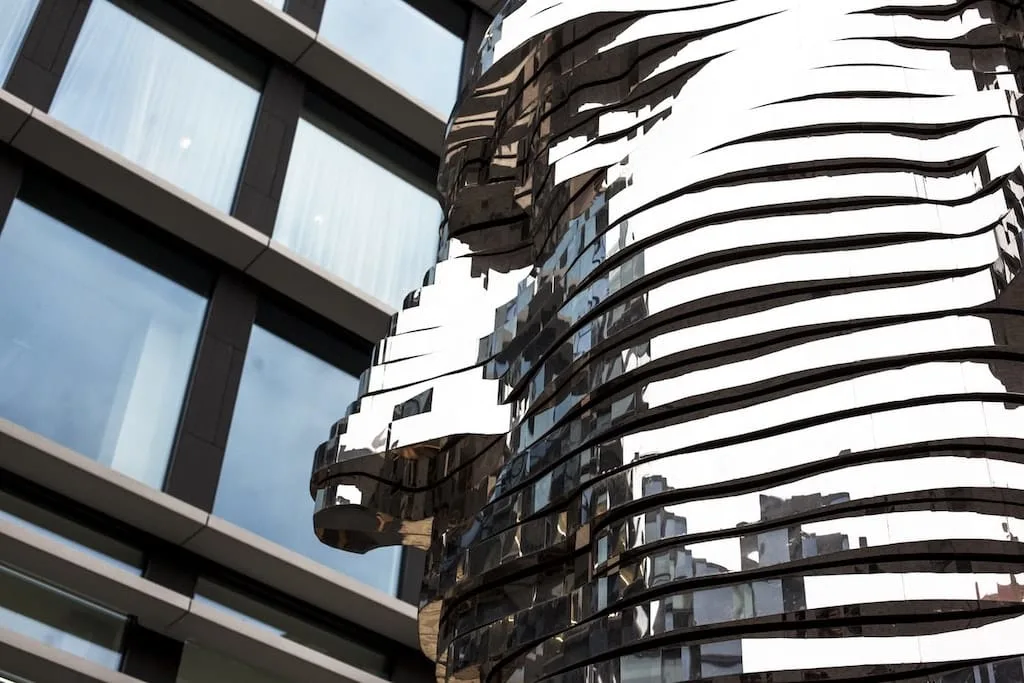
Historic Underground Of Plzen
Do you know that under the historical center of Pilsen City you can find 20 km of unique corridors, cellars, and wells?
A quirky landmark of the Czech Republic, the Pilsen historic underground spreads over three floors, and it is one of the most popular sights in Pilsen.
The construction of Pilsen Historical Underground began in the 14th century, and it is among one of the largest in the Czech Republic. Pilsen Historical Underground is situated 200 meters from the Main Square; the entrance is from Brewery Museum. You can see 800 m of these corridors during the guided underground tour.
The tour takes 50 minutes. Because the temperature stays around +6 °C during the whole year, the warm clothing and comfortable shoes are recommended.The tour is adventurous from the beginning. First, you receive the safety helmet, and then you continue to the underground.
You can admire former underground pubs, wells, dishes, tools, or the old wooden pipeline found here. The underground had served not only for storage of food, but also as a protection against fires and attacks. The most amazing part is at the end: the water wheel. The replica of an old water wheel was installed in 2005, and its diameter is 7 meters. The wheel is placed under the Water Tower, which you can find in Pražská street. The guide will turn on the wheel for a few minutes!
Together with the ticket for Pilsen historical underground, you will receive a beer voucher, in exchange for which at select Pilsen restaurants, you can taste 0.3l of Pilsner Urquell beer (only for those aged 18 or over). The voucher is, for example, valid in the nearby traditional restaurant “Na Parkánu,” where you can also have lunch. The daily menu tastes good, and it is not expensive, comparing to other restaurants.
Explored by Šárka Novotná from PlzenGuide.com
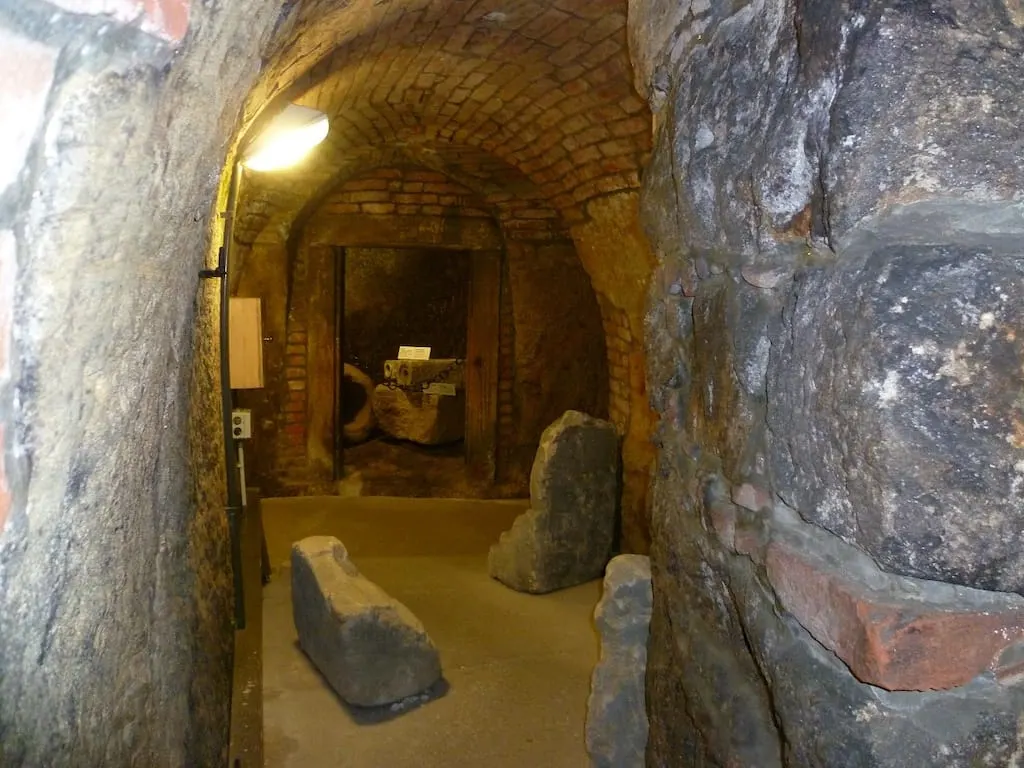
Holy Trinity Column
The Holy Trinity Column belongs to one the most sought-after landmarks of Moravia and the whole Czech Republic. It’s located in the historic center of Olomouc, Czech Republic’s 6th largest city.
Like most plague columns in Europe, this one was also built after a long period of a plague ravaging through the region. However, in the case of Olomouc’ Holy Trinity Column, the dedication put into the construction resulted in a plague column, which truly is one of a kind – mostly due to its size.
The column is so large that even a small chapel rests at its base. What’s more – 18 sculptures of saints, 12 light-bearer figures, and 12 relief busts of the apostles can be found on the structure. It’s then topped off with a sculptural group of the Assumption of the Virgin Mary and the main Holy Trinity sculpture. All in all, this is the largest group of Baroque statues on one object in the whole of Central Europe.
Built-in the 18th century, the column is just one of many masterpieces adorning Olomouc. A number of Baroque fountains are scattered around the historical center and, together with the column, create a wonderful memory of times long gone by.
It’s amazing that the column withstood even attacks of the Prussian army only a few years after its completion. But it’s only thanks to the locals who risked their lives and marched through town to ask the Prussian General to spare the Holy Trinity Column. This event was imprinted into the column once the war was over by adding a golden-like cannonball into its upper part. It’s still visible today.
The Holy Trinity Column was inscribed on the UNESCO World Heritage List in 2020, and thus this year celebrates its 20-year anniversary. You can travel to Olomouc comfortably by train from Prague; it only takes 2 hours and 15 minutes.
Explored by Veronika Primm from Travel Geekery
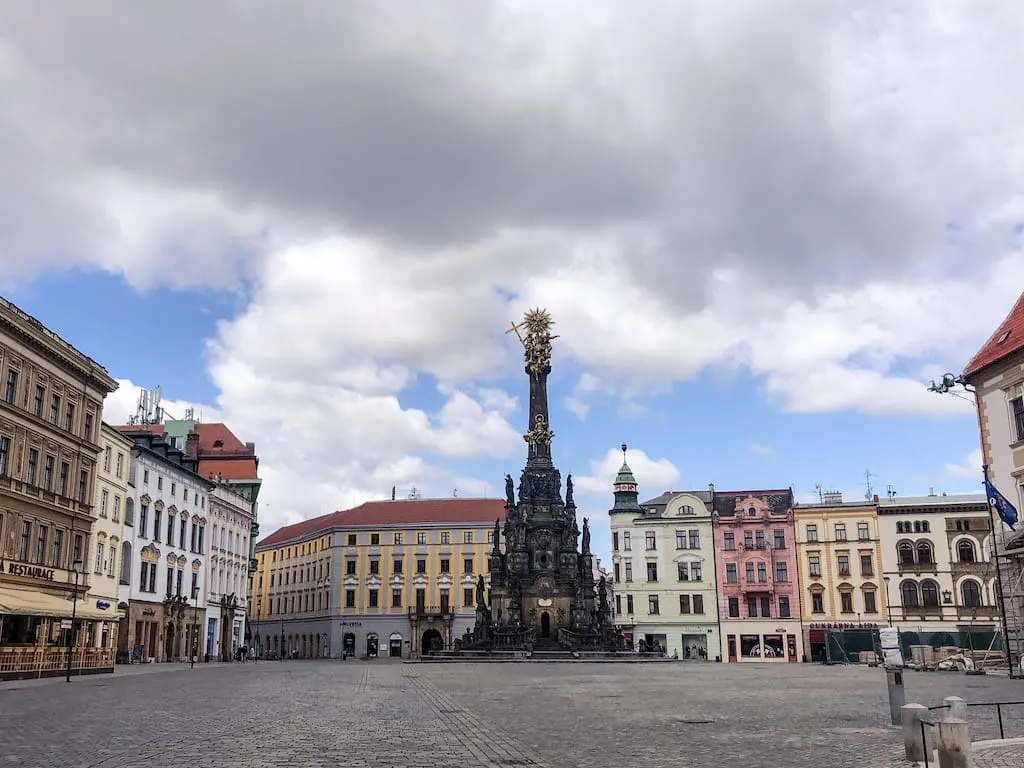
Ještěd Tower
Jested belongs to the most iconic structures in the Czech Republic. The tower sitting at the height of 1012 meters on a hill of the same name is located in the North of the country, just on the outskirts of Liberec city.
Jested Tower is primarily a TV tower. It was built following the design of a Czech architect Karel Hubacek in 1973, after a long ten years of construction. Among all submitted designs, Hubacek’s was a clear winner thanks to its timeless shape. The beautiful hyperboloid structure rose on the place of a former popular mountain cottage, which burned down in the ’60s. Hubacek was awarded a prestigious August Perret Award for the architectural design of the Jested tower.
The views from Jested are extraordinary. On a clear day, you can see as far as Germany and Poland. The green hills of the Jizera Mountains and Krkonoše showcase this pristine part of the country beautifully. In winter, Jested Hill is a popular mountain resort offering several slopes of various difficulty levels.
Apart from its communications function, Jested serves as a wonderful (now retro) hotel and also features a café and a restaurant. It’s a well-known destination for local tourists, and weddings take place there every weekend throughout the summer.
The interior of the Jested tower has plenty of windows, so you always feel like you’re in a spaceship. The tastefully decorated rooms of the hotel enhance that with funky wallpaper. The restaurant is so wonderfully bright with light and pleasant to visit year-round.
You can visit Jested easily from Prague – just take an hour-long bus ride to the city of Liberec (well worth seeing too) and then take a tram towards Jested. It’s only a few steps to a cable car. Or you can walk it up!
Explored by Veronika from Travelgeekery.com
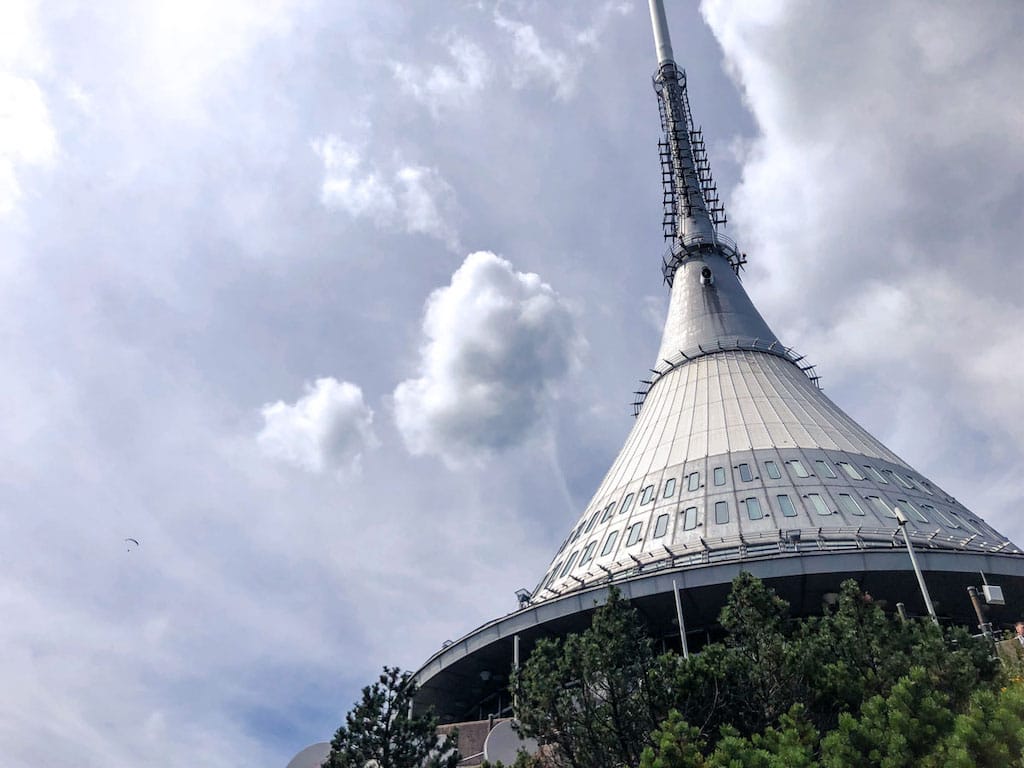
Karlstejn Castle
Karlstejn Castle is a popular tourist destination in Czechia, and not just because it is relatively close to Prague. Its setting on a rocky hill overlooking forests, the crenelated protective walls that surround it, and its picturesque towers combine to make it the quintessential medieval castle.
Unlike many surviving medieval castles, this one was not a residence for most of its history. Built in the 14th century by Charles IV, Holy Roman Emperor and King of Bohemia, its only residents were Charles and his son, Wenceslas IV, after him. After that, the main purpose of the castle was to serve as a safe storage space for the crown jewels and valuable religious relics.
While vans and horse-drawn carriages shuttle tourists back and forth from the parking lot below the village of Karlstejn, walk up yourself if you can. The road winds through the village, each turn providing a new view of the castle looming above.
The inside can only be visited on a tour, and the “exclusive” tour – also called “The sacred rooms of the castle with the chapel of the Holy Cross” – is the one that includes the most impressive rooms: St. Catherine’s Chapel, covered in gold leaf, precious stones and frescos, and the Chapel of the Holy Cross, also richly decorated, including 129 medieval frescos.
From Prague, plenty of half-day or full-day tours goes to Karlstejn. To go on your own, you can take a direct train from Prague central station to the village of Karlstejn in less than an hour. Alternatively, you can drive there easily enough, but here is a tip: once you start seeing signs pointing the way to Karlstejn, follow them instead of your GPS!
Make sure to check hours and book tours ahead. The “Sacred” tour is not offered from November until late May. Even the “basic tour,” which covers the rather sparsely-furnished rooms on the first and second floors, is not always available.
Explored by Rachel Heller from Rachel’s Ruminations
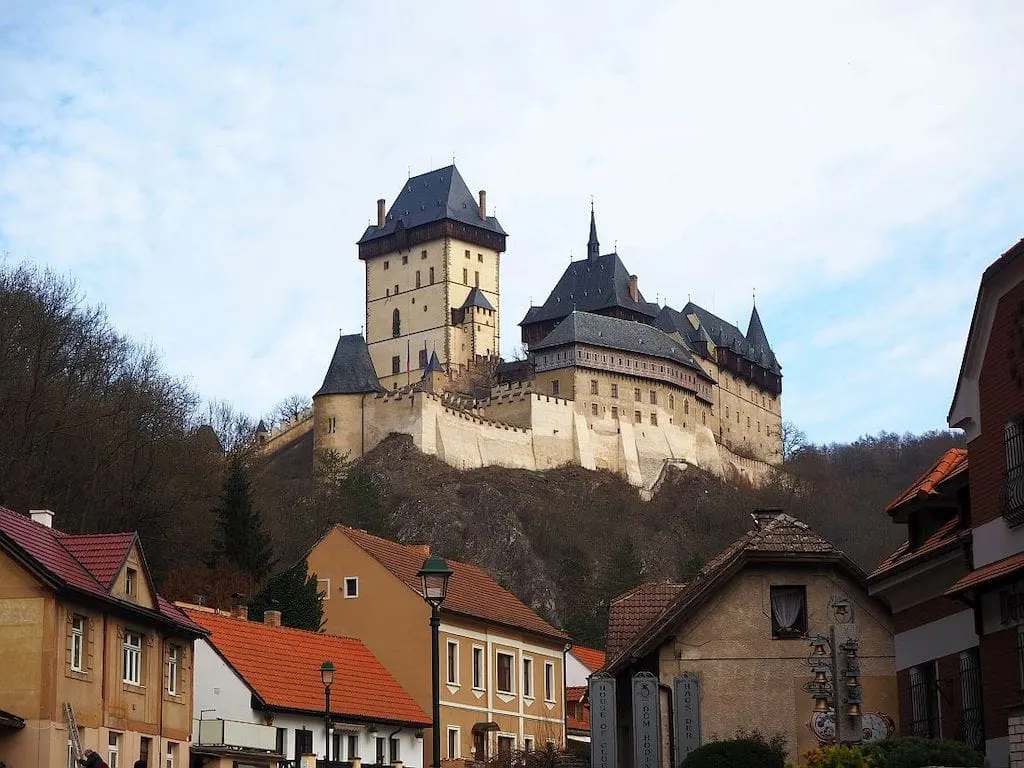
Konopiste Castle
Konopiště is one of those typical Eastern European castles, located about 50 kilometers southeast of Prague. But it’s a castle with a bittersweet story, as it used to be the home of Archduke Franz Ferdinand of Austria, the heir to the Austro-Hungarian throne, and his wife Princess Sophie, who were both assassinated in Sarajevo, sparking the fire that started the Great War.
The castle is open from April to October. From Prague, it’s easiest to drive, although going by train is also a pretty good way of visiting Konopiště Castle. From Prague’s central train station, buy a ticket to Benešov u Prahy. The train takes you there in about 40 minutes, and it’s a 2.5-kilometer walk to the castle.
Franz Ferdinand didn’t have a real interest in life at the Vienna court and found his perfect house and retreat in Konopiště where his castle lies in the middle of grand gardens. The castle was built in the 1890s and was accommodated with the latest technology as the archduke liked to be ahead of his time. It is one of the few historical castles in the Czech Republic that was built with running water, electricity, flushing toilets, showers, and even an elevator.
This alone would be interesting enough to visit the castle, but the archduke’s love for hunting makes a visit really fascinating, albeit slightly unsavory. Because the entire castle is decorated with hunting trophies by Franz Ferdinand, over 100,000 antlers, like the ones from chamois and deer, adorn the walls, and the corridors are lined by stuffed animals, anything varying from elephants to tigers. The archduke also collected artifacts about St. George, and his collection with almost 4000 pieces is also very impressive. You can only visit the castle by tour, and it’s prohibited to take photos inside.
After your visit, you may want to actually see some live animals, and the grounds and gardens surrounding will take care of that. The gardens are beautifully landscaped, and peacocks roam the lawns in a relaxed mode. In the surrounding area, you have a great chance of spotting deer, who don’t have to fear ending up on the walls of Konopiště castle.
Explored by Esther de Beer from Mooistestedentrips.nl

Kunětická Hora Castle
The Hrad Kunětická Hora is a castle in Pardubice, Czech Republic, which is only a short hour-long train ride from Prague. Hrad Kunětická Hora sits atop a volcanic mountain 6km from the city. The castle has had a violent history over the centuries.
Its strategic position high above the city made it important during several wars, such as the Hussite Wars in the early 15th century and the Thirty Years’ War in the early 17th century. Although the high position did not help in the Thirty Years’ War as the castle was besieged several times and burnt to the ground by Swedish troops. What is left has been restored and turned into a public museum, and you can take a tour to see the castle buildings and grounds. Inside the castle, you can find displayed the oldest known Renaissance mural in Bohemia. It is a mural depicting Samson and Delilah from 1523.
Hiking to the castle takes a bit of time due to the winding trail up the mountain. If you don’t want to walk up, there is a small train that will take you from the parking lot to the castle. But, once you reach the top, the views are worth the effort. The panoramic views of the countryside are lovely to see, and this is the perfect location to watch the sunset when visiting this area. Other activities for you to do while visiting are at the base of Kunětická hora.
There is a Gingerbread House where you can hear about the history and production of gingerbread, which is one thing Pardubice is famous for. You can also walk through Hansel & Gretel’s haunted fairytale forest. And there is also a small animal zoo for you to experience farm animals. Hrad Kunětická Hora makes a fabulous day out when you are visiting the Pardubice area of the Czech Republic.
Explored by Heather Raulerson from RaulersonGirlsTravel
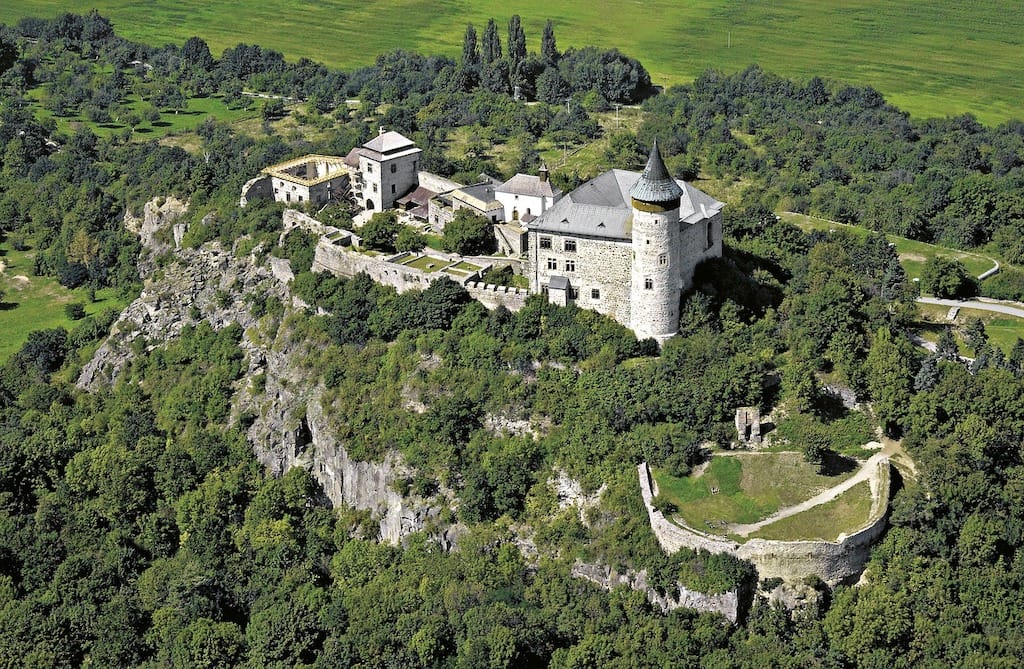
Lennon Wall
John Lennon Wall is a wall full of graffiti’s in Prague, which was used as a tribute by young Czechs to the famous musician after his murder in 1980.
Originally this wall in Mala Strana was known as a protest wall in the late 1940s with young people using the wall to air their grievances and complaints to the government. However, it only started with text and not a full art graffiti-like what we see now in John Lennon Wall.
From 1960 onwards, the wall was called the “Crying Wall,” and it was still used as a protest wall against the government. After the murder of John Lennon, the wall became a tribute to the musician, and the wall has become a symbol of global ideals – love and peace – which are also the focus of some of John Lennon’s songs.
The wall has changed several times, but it played a major role in activism, and it remains one of the catalysts for political reforms in the country. What I also like about this wall is how people all over the world use street arts to share these positive messages. And how a lot of people believe in the beauty of these messages. As a traveler, who is continuously hoping for a better world, this surely touches me.
John Lennon Wall is also easy to find. The major attractions in Prague are within walking distance to each other, so you are mostly going to pass by here. But if you are coming from Charles Bridge, it’s a quick 5-minute walk to the wall. It is also just across the French embassy, so it’s unlikely you’re going to miss it.
Explored by Christine Rogador from Guide To Day Trips
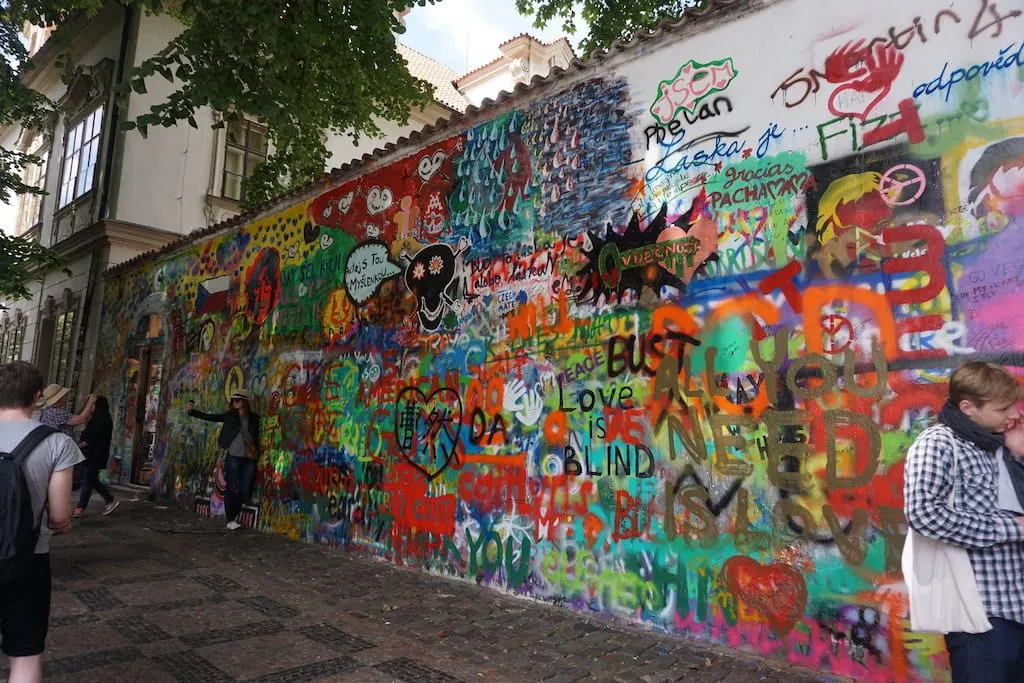
Lidice Memorial
The story of the town of Lidice is one of the great tragedies of World War II. It was the scene of the most violent and spiteful part of the aftermath of one of the most important events of WWII: the assassination of Reinhard Heydrich, one of the main architects of the Jewish Holocaust.
Following Heydrich’s death at the hands of a group of Czechoslovak soldiers, Adolf Hitler launched an investigation, promising swift and merciless retribution. In retaliation for Heydrich’s death, any village that was thought to have harbored or helped any of his assassins was ordered to be wiped off the map forever. Unfortunately, Lidice was on that list.
In accordance with Hitler’s directions, on the 9th of June 1942, the town was leveled by soldiers, and all occupants were either killed, taken to concentration camps, or, in the case of several children, taken to Germany to be given to the SS families to Germanize and raise as their own. However, the vast majority of the children of Lidice were killed shortly after their town was razed – only 17 eventually made it home.
Today the area of land that Lidice occupied has been turned into a memorial and sculpture park. The areas where the original church, school, and graveyard stood are all marked, and there is a large gathering of statues dedicated to the children of the town.
The Lidice Memorial is not an easy visit, but it is a profound one and undeniably an integral part of the history of the Czech Republic. It is an important landmark for the Czech people and one that many visit for school. The site is a 30-minute drive from Prague city center and can be reached by busses which travel both to and from the town regularly throughout the day.
Explored by Jeremy from Cultura Obscura
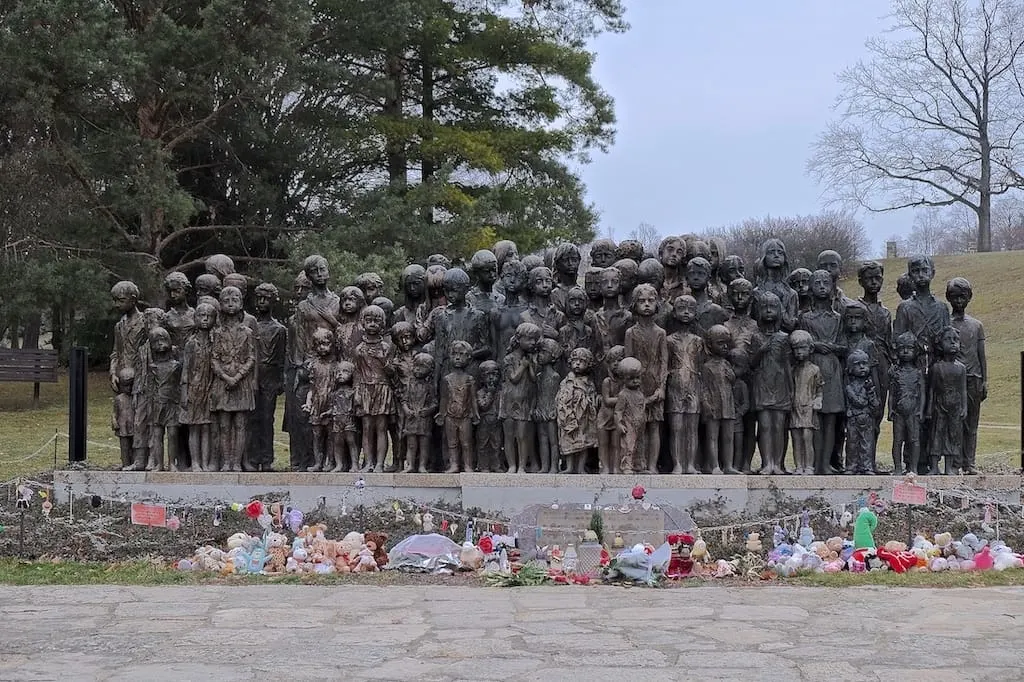
Mill Colonnade
Karlovy Vary is a gorgeous spa town in the West Bohemia region of the Czech Republic. Since the mid-1800’s European and international celebrities have flocked to this thermal spa resort town in the Czech hills for treatments and relaxation. It’s full of Old-World charm and gilded architecture, especially in the spa district along the river.
One riverside landmark that visitors cannot miss is the Mill Colonnade. It’s one of several colonnades with columned walkways and the most grandiose in Karlovy Vary. The iconic structure took ten years to complete and was unveiled in 1881, and visiting the Mill Colonnade is one of the best things to do in Karlovy Vary.
The Mill Colonnade comprises two walkways, a nave, and 124 Corinthian columns. It stands not only as a traditional image of Karlovy Vary but to house fountains from the hot springs of the city. There are 13 major thermal springs in Karlovy Vary, and the Mill Colonnade has five of them. They range in temperature and history, but all are thought to possess medicinal properties due to the high mineral content. Therefore, visitors frequently drink from the fountains that deliver water from each spring.
When you visit Karlovy Vary, you can purchase a ceramic cup in order to drink from the springs. Vendors sell them around each of the colonnades and in all gift shops. Many only take cash, but there is no entry fee to visit the Mill Colonnade and drink the healing waters within. Visiting the iconic landmark and experiencing the water is a must-do event in Karlovy Vary.
Explored by Derek Hartman from Robe Trotting
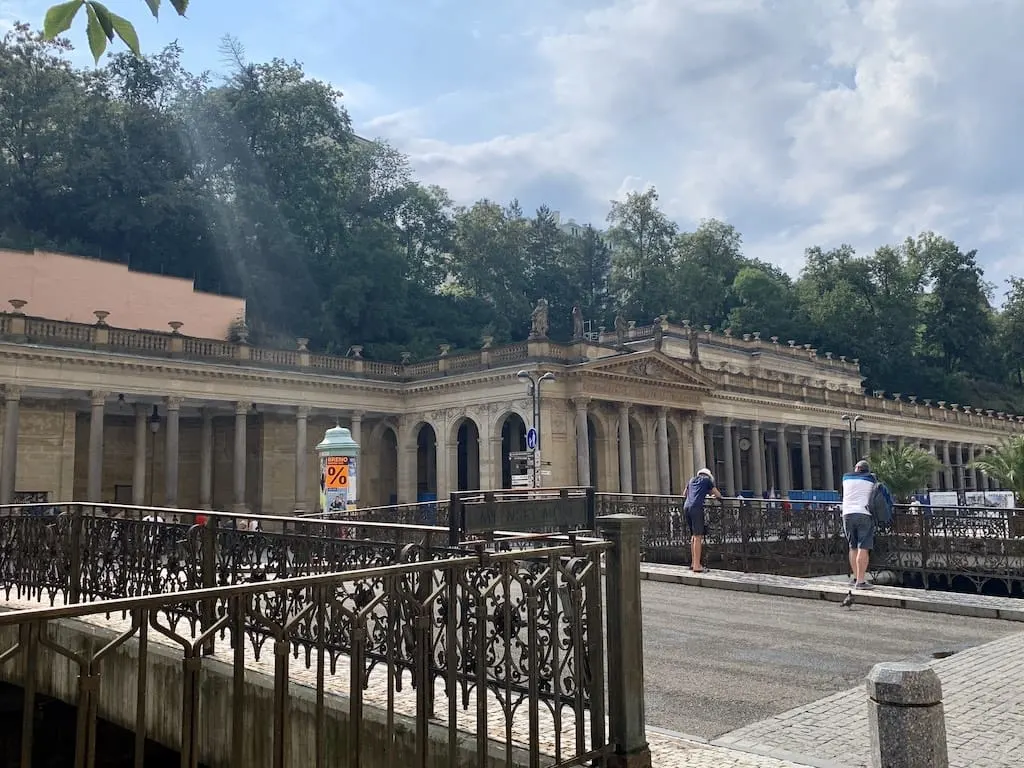
National Theatre Of Prague
Prague’s National Theater is regarded as the alma mater of Czech opera, and as a symbol of Czech culture and art. It is also a landmark of the Czech Republic. Opened on the 11th of June 1881, a visit here is just as stunning as watching the Opera in Vienna but at a much lower price. Prague has a long musical history, and when visiting, you cannot pass up the opportunity for an evening of breath-taking orchestras, choirs, and dance performances.
Tickets book out far in advance, especially for shows on and around Christmas Day, so you should plan ahead and consider shows at either the prestigious National Theatre of Prague, the Estates Theatre, or Karlin Theatre. Prague in December means theatres are guaranteed to trot out the classics like Swan Lake and the Nutcracker Ballet. Still, you can also find more modern performances of ballet and Opera by both Czech and foreign authors if you look hard enough.
And even if the ballet is not quite your cup of tea, the Neo-Renaissance and Rococo interiors put Prague’s National Theatre amongst the most beautiful theatres and opera buildings in the world ‑ and are worth seeing in their own right. There are many ticket re-seller sites for Prague events, but in most cases, you should go directly through the venue website to avoid paying any extra fees.
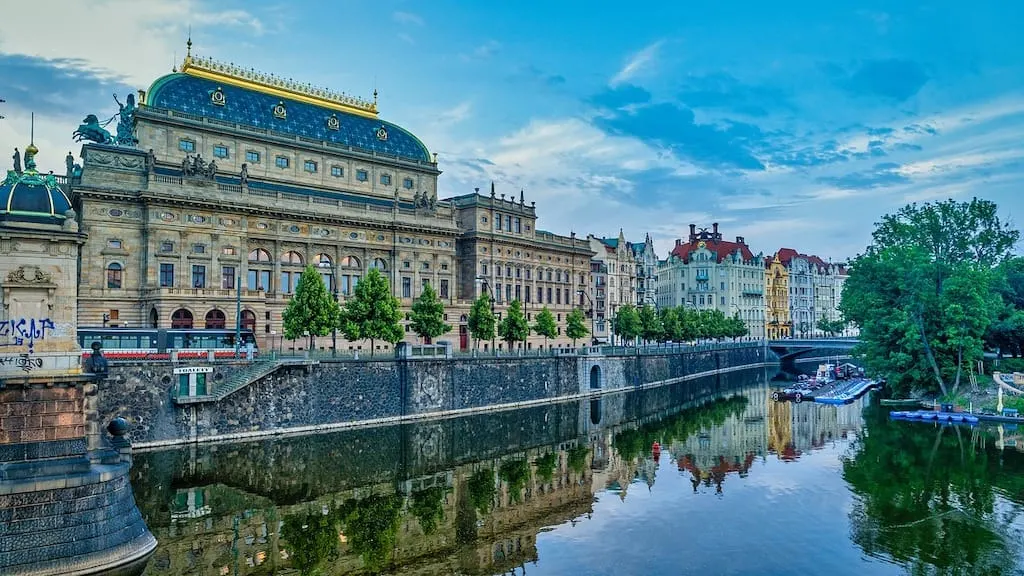
Old Jewish Cemetery In Prague
There’s a very specific feeling that washes over you when exploring the Old Jewish Cemetery in Prague. As you wander the pathway that separates the piles and piles of tombstones, a sense of calm sweeps over your mind, and you can’t help but be at peace within the hallowed walls.
Within the walls lie over 12,000 tombstones, but there are far more souls that are at rest in this space. From 1439 until 1786, thousands of members of the local Jewish community were buried there.
In fact, there were so many that they soon ran out of space. Despite expanding the cemetery several times, they still found there was not enough room to house the deceased. Because of this, they began to bury their loved ones on top of the previously buried members of the community. There are as many as twelve layers of people buried in any given spot. When the cemetery was too full to accommodate more burials, they added another layer of dirt on top of the existing burial plots, and they moved the tombstones to the top of the new layer of dirt.
This has resulted in the cumulation of thousands of tombstones that appear to be stacked upon each other, sticking out of the ground in a jagged display that leaves a lasting impression upon your mind. The cemetery can be found in the Jewish Quarter of Prague; access to the Old Jewish Cemetery is included in the purchase of a tour ticket for the Jewish Museum (for 200 CZK) or for the Prague Jewish Town (for 270 CZK).
This is a site that is definitely not to be missed while visiting the Czech Republic but be sure to plan your trip accordingly, as the cemetery is closed on Saturdays and Jewish holidays.
Explored By Wendy Pennell from Wendy in the Wind

Pilsner Urquell Brewery
The world-famous beer Pilsner Urquell is brewed in the Czech city of its name Pilsen. Pilsner Urquell was the world’s first pale larger and largely copied by others; hence the name Pils or Pilsner was born and associated with many light-colored beers. The brewery came about after a merger of many small breweries in Pilsen in the mid-1800s.
Today the beer is known worldwide, and beer lovers are drawn to Pilsen to visit the brewery. The brewery tour runs hourly in many different languages and allows you to sample the beer straight from the barrels underground on the tour. The tour talks about the history of the beer as well as how the small breweries came together to make one of the world’s most popular beers in the world today.
You are taken to the bottling plant and the underground cellars where it is stored. Your guide will happily answer any questions you have. The brewery site has an amazing gift shop selling everything you can think of and a restaurant selling food that matches the classic beer that is brewed onsite. The tour is one of the best brewery tours we have done.
If you are staying in Pilsen, the brewery is easily reached by walking through the amazing city center.
By Bec from Poland Travel Expert
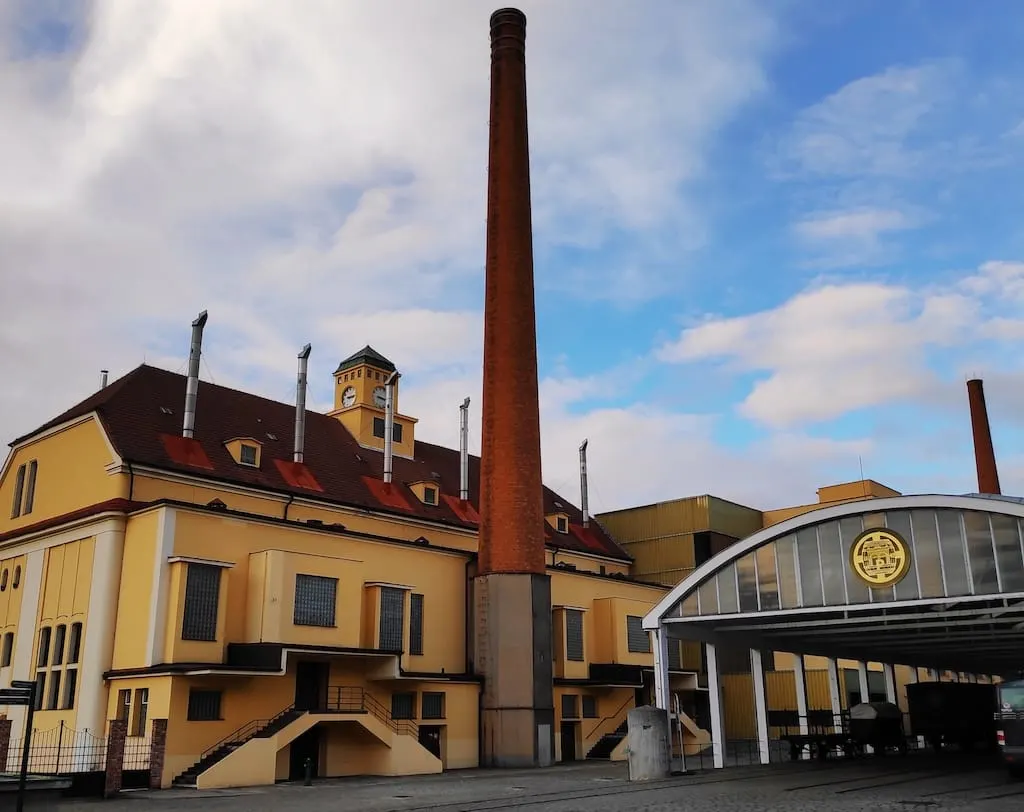
Prague Astronomical Clock
If you were to count the number of landmarks in Prague, you would be here for a long time. From the Charles Bridge to the Prague Castle, Prague is filled with astonishing historical landmarks that will mesmerize any visitors. One of the most notable attractions in Prague is the Prague Astronomical Clock, a medieval device used for astronomy.
Mounted on the southern wall of Old Town Hall in the Old Town Square, the Prague Astronomical Clock is an unmissable attraction in Prague’s historic center. If you ever happened to walk past by it on the hour, you will usually notice a huge crowd standing in front of the nearly 70-meter tall medieval building. Why? Because every hour from 9 am to 11 pm, a show known as “The Walk of The Apostles” occurs at the Astronomical Clock. The exciting 27-second performance sets the twelve apostles and the other figures (such as a figure that represents death) around the clock in motion.
Though physically, it might not be the most spectacular landmark in the Czech Republic, it comes with a dramatic history. Installed in 1410, the Prague Astronomical Clock is the third-oldest astronomical clock in the world and the oldest functioning clock. However, the clock didn’t always look like that.
The present-day presentation is a recent renovation from the damages done Prague uprising in the Second World War. The clock was badly damaged then, and repairs have been made extensively to restore its appearance and functionality. Because it is over 600 years old (over twice the age of the United States), maintenance has to be performed regularly, sometimes disrupting the service of the clock.
Explored by Sean from LivingOutLau

Prague Castle
Prague Castle is one of the most beautiful fairytale castles in Europe, and a must-visit when exploring the Czech Republic. The castle is known as the largest coherent castle complex in the world, and it’s listed as a UNESCO World Heritage site. It was founded around 880, but it has been renovated many times through the centuries.
The castle complex consists of many palaces and ecclesiastical buildings, such as the Old Royal Palace, St. George’s Basilica, and St. Vitus Cathedral, which is the largest and most important temple in Prague. Another unmissable sight is the Golden Lane, a little street within the castle grounds boosting cute little houses on both sides. The street was originally inhabited by goldsmiths, and it was called Goldsmith Lane in the 16th century before it eventually became Golden Lane.
The historical buildings are open from 9 am to 4 pm in winter and 5 pm in summer, while the castle complex can be visited between 6 am-10 pm every day. There are different types of tickets based on which sites you want to visit.
If you want to visit everything (St. Vitus Cathedral, Old Royal Palace, the exhibition of “The Story of Prague Castle,” St. George’s Basilica, The Golden Lane with Daliborka Tower, and Rosenberg Palace), you need to buy a “Circuit A” type ticket for 350 CZK. It’s also possible to rent an audio guide or request a guided tour for additional costs.
Getting to Prague Castle is really easy; you can just walk up from the Old Town, and there are also several tram stops and metro stations nearby.
Explored by Krisztina Harsanyi from She Wanders Abroad
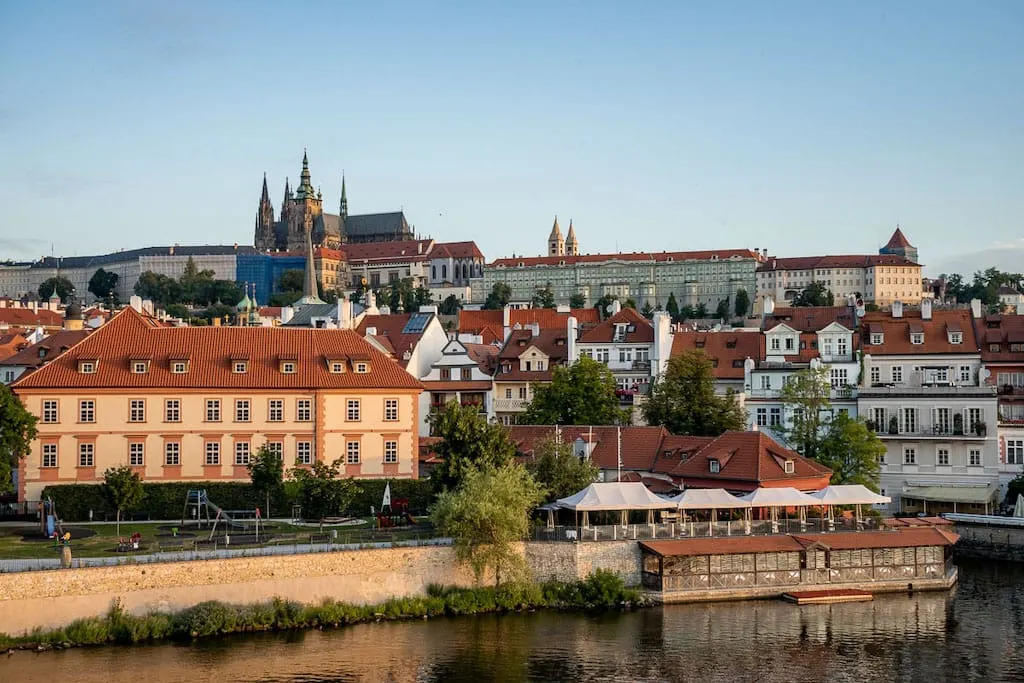
Prague Christmas Markets
Christmas in Prague would not be complete without the festive Christmas Markets – and those of the Old Town Square and Wenceslas Square give the famed Christmas Markets of Germany a run for their money. Open every day from the 2nd of December till the 6th of January, including all the big holidays; there is no better place to experience the festive atmosphere of Prague in December.
Browse the handicraft markets, partake in Christmas carols, indulge in delicious snacks, and warm up with hot drinks. The Christmas Markets of Prague is a winter wonderland. But if the crowds at the main spots become a bit too much, you can also look for the smaller (yet equally enjoyable) markets at Prague Castle, Havel’s Market, Kampa Island, or on the Republic Square…or better yet, just visit them all!
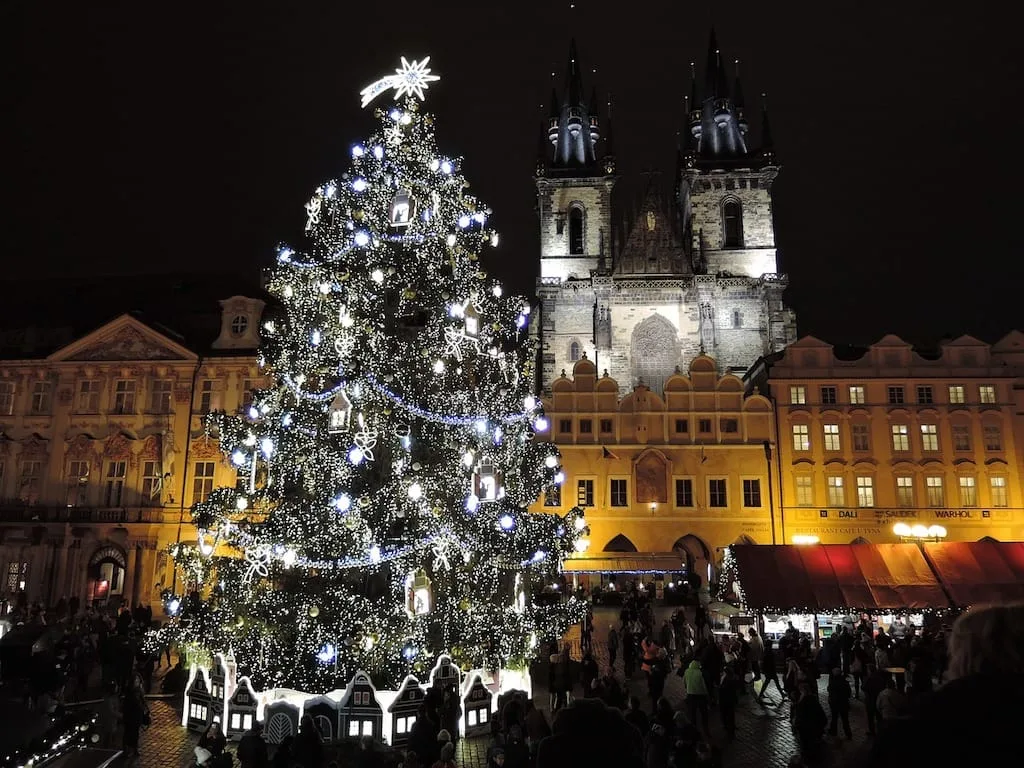
The Historic City of Telč
The city of Telč is a beautiful Czech landmark in the Vysocina region of the Czech Republic. Its historic center was built in the 14th century has been a UNESCO World Heritage Site since 1992 and consists of a beautiful market square, a gothic castle, and some fascinating underground tunnels. With a population of only 5300 people, this small town definitely fits the bill if you are looking for a hidden gem.
The historic Zachariáš of Hradec Square in the center of town is a huge cobblestoned square surrounded by merchant houses. These merchant houses are painted in colorful shades, and the gables of the houses are intricate and very detailed in their carvings and decorations. Zachariáš of Hradec, the Duke of the region, went on a trip to Italy and was inspired by the up and coming Renaissance architecture and had his chateau built in the popular Renaissance style. When Telč burned down in the 16th century, the local merchants decided to rebuild the whole town to resemble that style.
Today, just like in the times past, the top floors are residential apartments, and the ground floor is occupied by shops and restaurants. Below the buildings and market square, you will find a network of underground tunnels. They were used for the storage of goods as well as escape routes during invasions. You can take a tour and explore the city below the city, but beware. Supposedly, the tunnels are haunted! Also, don’t go if you are claustrophobic or very tall, as some of the tunnels are more crawlspaces than tunnels.
The High Gothic castle in Telč – Roštejn Castle – is also worth a visit, and if you can find the time, a stroll around the beautiful gardens is highly recommended.
Explored by Maria Haase from Europe Up Close
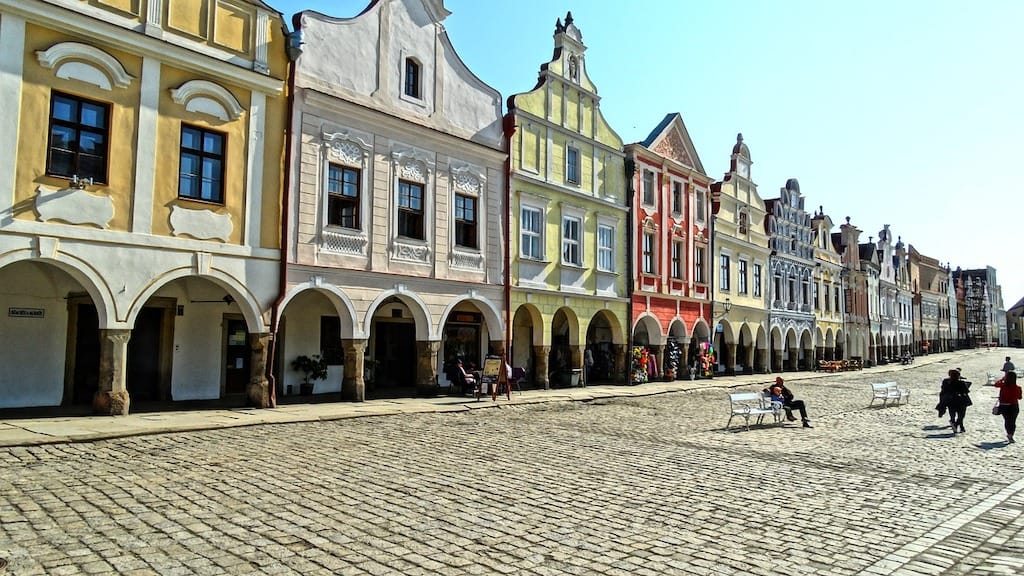
Villa Tugendhat
Lesser visited compared to Prague, the university city of Brno is packed with incredible sites and a fantastic, local, and young atmosphere that makes it an extremely pleasant place to visit. Although most tourist sites and landmarks are scattered around the historic center, it’s a bit outside of the town center that you will find one of the most impressive places to visit in the Czech Republic – Villa Tugendhat.
Declared a UNESCO World Heritage Site in 2001, Villa Tugendhat is totally worth the effort of going all the way there. The villa was commissioned by the Tugendhat’s, a Jewish couple living in town who had inherited the land. It was designed by architect Ludwig Mies van der Rohes and built in the 1930s to reflect his world and design vision, and as such, it is a great example of Functionalism, an architectural trend that sees plain lines, large open spaces, and rooms with a purpose.
The villa is characterized by ample rooms with large windows and doors facing an impressive park with stunning views (make sure to go before sunset!). Infrastructure is simply state-of-the-art – especially if you consider that the villa was built in the 1930s. There even was air-conditioning!
During the Nazi occupation, the family was forced to abandon the place and fled the city as the villa was occupied by Gestapo and used as an office. When the Russian cavalry liberated Brno in April 1945, the villa was used as a stable for horses and much of the furniture burnt as firewood. It was only in 1967 that owner Greta Tugendhat returned to Brno.
The villa was added to the list of National Cultural Heritage sites in 1969, and restoration works started in the 1980s. It opened to the public in 1994.
Only guided tours are available – in a variety of languages. They must be booked well in advance as a limited number of visitors are permitted daily.
Explored by Claudia Tavani from My Adventures Across The World
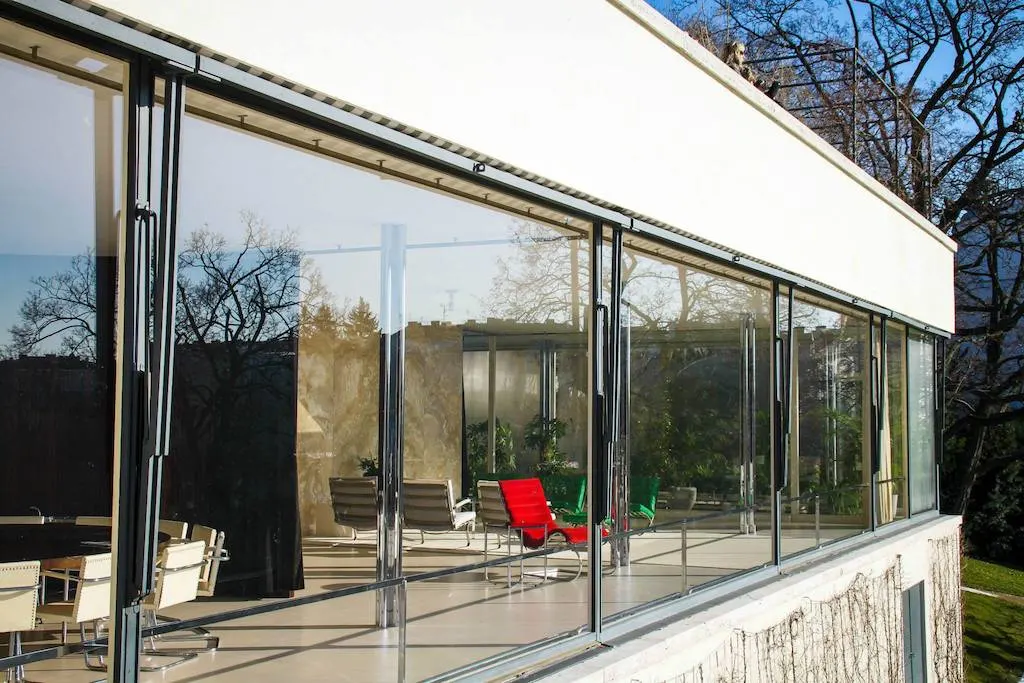
Žižkov Television Tower
Undoubtedly one of the most famous landmarks in Prague, at 216 m in height, the Žižkov Television Tower is also the city’s highest structure. At 93 m from the viewing platform, Prague is set out before the eyes with a 360-degree perspective.
One whole floor is devoted to relaxing, and above all, to fine dining experiences. In the 1980s, the tower was constructed by the architects Václav Aulický and Jiří Kozák, but — like several examples of Communist-era TV towers in Central and Eastern Europe like in Tallinn and Riga —, the local people used to hate the TV tower.
As a result, it also earned a series of nicknames, many referring to its rocket-like shape, namely “Baikonur,” after the Soviet cosmodrome, or some other more ideological, like “Jakeš’s finger” after the Czechoslovak Communist Party’s Secretary-General. But, like many famous landmarks around the world, the monument has come to be loved. The tower’s popularity among Czechs has recently strengthened, which likely started in 2000 when sculptures of crawling babies were added here by the Czech artist David Černý. Intended to be temporary, locals appreciated the paintings, and they were returned as a permanent display in 2001.
With its architectural advances and views of the city skyline, the Žižkov Television Tower still continues to draw tourists to this day.
